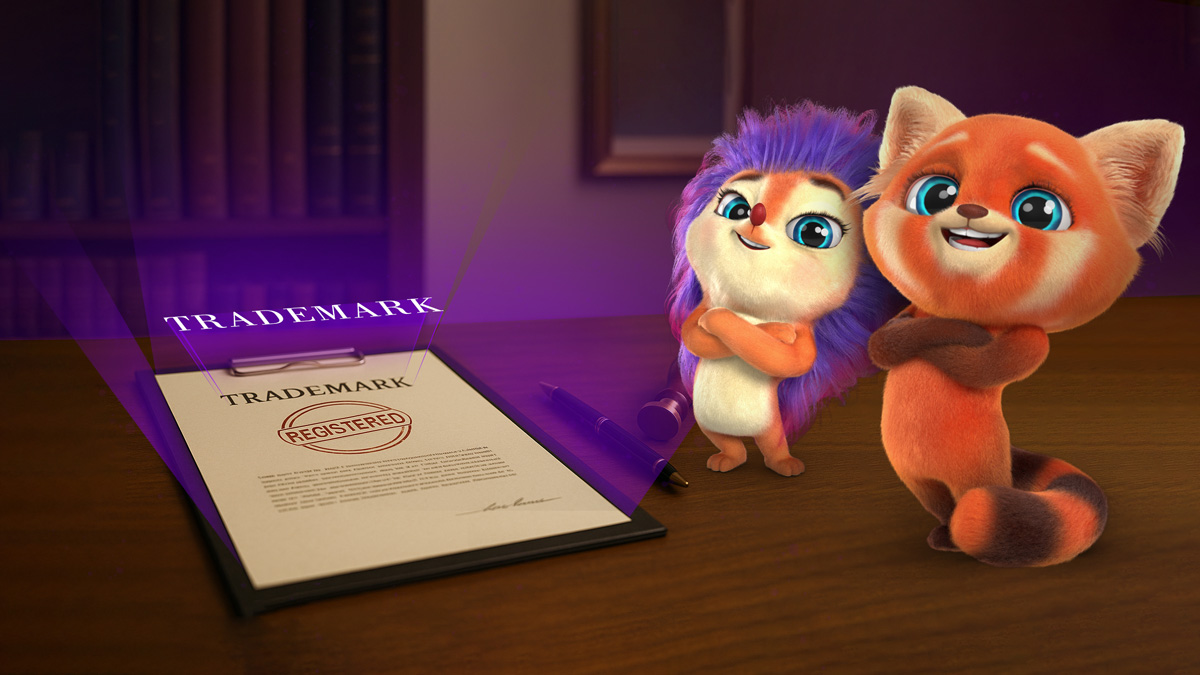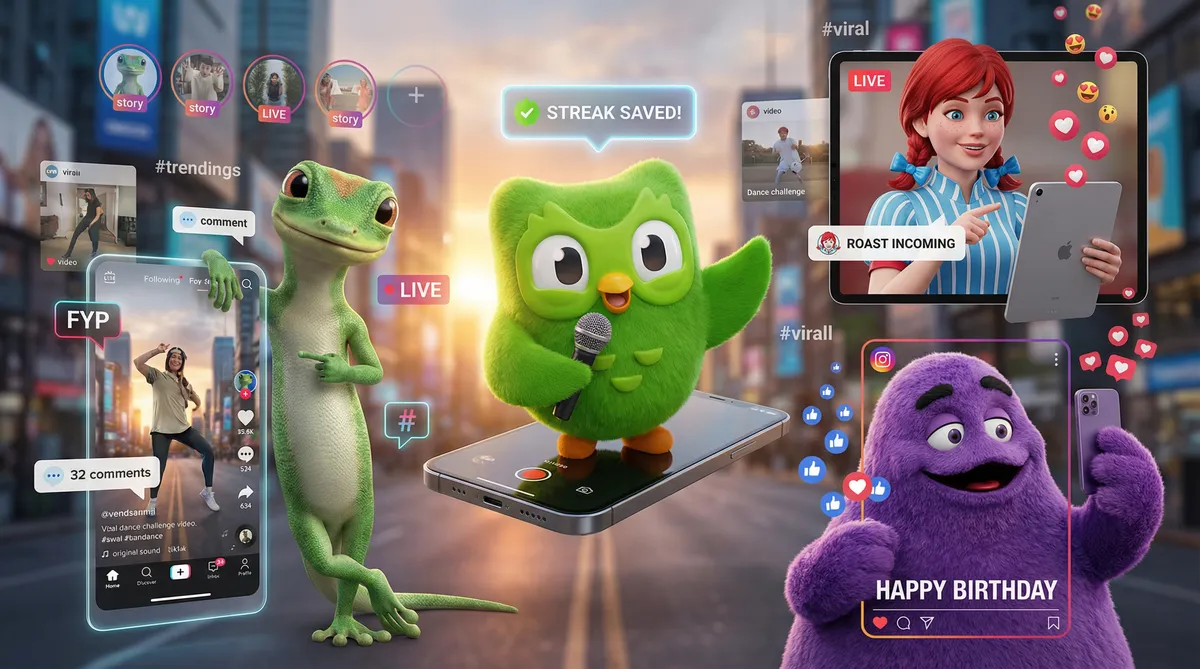
To understand how to protect this invaluable asset, you first need to know what brand mascots are and why they are so important for your business. But once you have a successful mascot, what if others try to misuse it for fraudulent purposes? How can you stop them?
Trademark law safeguards your mascot, and in this blog, we’ll discuss the importance of trademarking your mascot alongside a step-by-step guide to show you how to do it.
First, let’s gain more information on trademarks and their significance.
What Are Trademarks and What Benefits Do They Offer?
Trademarks help brands distinguish their offerings from those of other businesses in the market. A trademark is a distinctive sign that can be a word, symbol, design, or a combination of these elements.
In simpler terms, trademarks aim to protect the brand from unauthorized uses and provide it with the proper infrastructure to take legal action, if necessary.
Regarding the advantages of trademarks, besides the legal protection they offer, they also grant you ownership and the exclusive right to use the mark to promote your business’s goods and services, which is a highly valued benefit.
Additionally, trademarks help your brand stand out—a kind of differentiation that facilitates gaining trust and making the brand a renowned business in the eyes of target audiences.
This type of protection can also be a powerful weapon against probable counterfeit products that try to use your reputation to deceive customers and sell their low-quality offerings.
In summary, trademarking allows you to secure ownership of something alongside the exclusive right of how you decide to use it. Now, the main question arises.
Is it Possible to Trademark my Brand’s Mascot?
Yes, you can trademark your brand’s mascot. Let us make it clear that trademarking a mascot is not only possible but also necessary to protect your brand’s representative from unauthorized use by fraudsters.
Interestingly, you can trademark the appearance of the mascot and its name simultaneously. This means that if any individual or company uses your trademarked mascot without your permission, they must face the law, as you can sue them for violating your legal rights.
Trademarking is an effective way to protect your assets, but there are other options available for this purpose. One is copyright, and the other one is IP character. You can get more information about the latter in the blog “IP Characters: From Design to Licensing + 12 Examples.”
While all three aim to protect, they function differently.
Copyright protection is usually used to secure the ownership of creative works for creators. For example, musicians and filmmakers use this kind of safeguard to grant the ownership of their content.
IP character protection, on the other hand, applies only to fictional characters, such as mascots. So, there is a relationship between this and the trademarking mascot method, which we’re examining here. They both want to safeguard the mascot from any potential misuse. However, despite sharing a vision, they act differently in their jobs.
As mentioned earlier, trademarking allows you to obtain ownership of the mascot’s looks and name. However, IP character offers a more comprehensive package, including everything related to the mascot, such as its profile.
In other words, by trademarking your mascot, you’ll turn it into an intellectual property, AKA an IP Character. Additionally, it’s suggested to plan for copyright protection to build a robust castle around the mascot and prevent potential misuse.
What are The Benefits of Doing This?
Here’s a quick recap of the advantages you’ll access by trademarking the mascot:
- Establishing exclusive rights to use the mascot in commercials.
- Enhancing brand recognition and awareness.
- Fostering an emotional connection with target audiences.
- Preventing any unauthorized access and unpermitted imitations by fraudsters.
- Paving the way for future merchandising plans.
- Increasing the value of the fictional character that serves as your brand’s mascot.
- Providing legal advantages in case of any violation.
- Differentiating your brand in a professional manner.
Multiple well-known brands have already taken this approach and trademarked their mascots, and we’ll mention some of them in the next section.
Examples of Mascot Trademarks
In this part, we’ll review five renowned brand mascots trademarked by their respective brands for maximum protection.
-
Tony the Tiger (Kellogg’s Frosted Flakes)
Tony the Tiger has been the face of Kellogg’s Frosted Flakes for more than seven decades. Now, people will recall the brand associated with it when they see the smiley tiger’s face. This wouldn’t have been possible without trademarking the mascot since imitators have always wanted to copy it and take advantage of its popularity.
However, the company managed to nullify all fraudulent attempts, thanks to trademark protection.
-
Chester Cheetah (Cheetos)
Chester Cheetah is a world-famous mascot that is known even in developing countries. Cheetos, the owner of the mascot, trademarked it and prevented any attempts at misuse.
-
Mr. Peanut (Planters)
Believe it or not, Mr. Peanut’s birthdate goes back more than a century. Naturally, such an old and established mascot is a prime target for fraudsters. However, trademarking the mascot helped the Planters managers protect their highly valued asset over several years.
-
Pillsbury Doughboy (Pillsbury)
Pillsbury Doughboy, the company’s mascot, has appeared in numerous commercials and has been used in several marketing campaigns since 1965. The managers of Pillsbury have successfully secured the ownership of their well-known face by trademarking it.
-
Energizer Bunny (Energizer)
Lastly, the youngest on our list, Energizer Bunny, represents the Energizer company and is protected by trademark laws.
Now, let’s move forward and discuss the procedure of trademarking a mascot.
Trademarking Mascot: Step-by-Step Guide
After gathering information about trademarks and their use cases, it’s time to take action and learn how to trademark your brand’s mascot.
1. Determine Eligibility for Trademark Protection
You have to use your mascot to be able to trademark it. This is a basic principle of trademark law that indicates one can’t trademark something that isn’t used in connection with goods and services of a specific brand.
As mentioned earlier, trademarks help protect identifiers that are used to differentiate a business’s offerings. Therefore, if you haven’t used the mascot before, there is no chance of trademarking it.
In other words, you must actively leverage the mascot in commercials to distinguish the source of goods and services you try to sell.
Moreover, there are other conditions for considering a mascot qualified for trademarking. For example, your brand’s representative must be unique in every aspect. Trademark law won’t protect mascots similar to those already protected under existing trademark laws.
Proving ownership of the design is also essential. You must have full rights to the mascot creation in order to trademark it.
Once you have ensured your brand’s mascot is eligible for trademarking, proceed to the next step.
2. Conduct a Comprehensive Trademark Search
As stated earlier, the mascot’s originality and uniqueness are unnegotiable trademarking terms. That’s why, in the second step of the process, you must conduct thorough research on previously trademarked mascots. The goal is to confirm your mascot is not similar to any other. This will prevent potential legal conflicts in the future.
You can check some sources, such as Trademarkia, the Trademark Search System (TESS), and the United States Patent and Trademark Office (USPTO).
We suggest extending your research as much as possible. If you fail to detect an unknown mascot like yours, you may encounter unforeseen challenges that will cost you money and time.
In the research process, look for any alikeness in appearance, design, name, and even the goods and services associated with that mascot. In general, any resemblance that could cause consumer confusion is a red flag.
3. Prepare Your Trademark Application
After researching, it’s time to fill out an application to trademark the mascot legally. The more detailed and clear the application, the better, as this decreases the possibility of rejection. In that case, you must dedicate time to polishing the application with more information.
In this blog, we’ll discuss the procedure of trademarking in the U.S. as an example. Please note that different countries follow different rules, and you must do your own due diligence to gain the needed information about where you plan to trademark the mascot.
In the United States, the USPTO, which stands for the United States Patent and Trademark Office, is responsible for applying trademark protection to various elements after receiving the application from the brands.
According to the terms defined by this office, your application must include a clear drawing or depiction of the trademark you want to register. In fact, you must add a detailed mascot drawing in the application form. If your application gets accepted, this drawing will become a part of the public record and be printed on your certificate. Therefore, you won’t be able to significantly change the appearance after submitting the request. That’s why we have to emphasize that you try your best to give them an accurate illustration of your mascot.
In addition to the drawing, you must specify what goods and services are associated with your brand’s mascot. To ensure you’ll provide them with the proper description, we recommend you read the manual USPTO offers for various categories of goods and services. This way, you can write the description using the correct terminology and give them the information they need to register the trademark.
Remember, the application should mention the mascot’s distinctive features. Additionally, avoid vague terms that are hard to understand. Prioritize clarity by using the language the USPTO expects in the form.
4. Submit Your Application to the USPTO
Applying through the USPTO’s Trademark Electronic Application System, AKA TEAS, has two primary filing options: TEAS Plus and TEAS Standard.
The former is the cheaper option, priced at 250 USD. The latter costs 350 USD and is suitable for applications that need to write descriptions not found in the USPTO’s manual.
In general, paying more allows you to skip some of the detailed requirements. The Standard version of TEAS is more flexible and easygoing. On the contrary, TEAS Plus is stricter and forces you to write down all information about the mascot in the form.
Based on your needs and the products you sell, select the best option and proceed to the next stage.
5. Examination by the USPTO
In this step of the process, there’s nothing to do but wait. After submitting the request for trademarking the mascot in the previous stage, it will receive a serial number and be placed in the queue for examination.
A USPTO attorney will review your application, which may take several months. To get information on how the process is progressing, you can check the status of your file on the TSDR system.
The assigned attorney checks your application to ensure it does not violate laws or conflict with other claimants. Simply put, they are responsible for confirming that your brand’s mascot is eligible for trademark protection.
If there is a problem, you’ll be notified through an official letter detailing the issue. Then, you’ll have six months to solve all problems and respond to the office.
6. Publication for Opposition
The application’s approval by USPTO is not the end. After that, your trademark enters the final phase: publication for opposition. This stage allows other individuals and brands to raise objections if they believe that the mascot’s trademark will harm their existing trademark.
In simple words, USPTO will publish your trademark in the official publication of the office, TMOG, short for Trademark Official Gazette, an online weekly journal. By doing this, approval of your request for a trademarking mascot will be noticed, and others can file an opposition within 30 days if they believe their rights are violated.
If there are no objections and the USPTO does not receive any opposition in this period, or if all oppositions get resolved in your favor, the USPTO sends the trademark to the registration phase. After that, if everything goes well, you’ll receive a Notice of Allowance, which means you successfully trademarked your mascot and can rest assured that it is protected by law.
Remember that monitoring trademarks and possible misuses is critical and never-ending. Let’s discuss this further in the next part of the blog.
You Need to Enforce and Monitor Mascot’s Trademark Continuously
All trademarked mascots that have served brands for decades and helped them reach various marketing and advertising goals were constantly monitored by accountable managers in those companies.
The USPTO suggests that to keep your trademark registration active and valid, you must continuously use it in commerce. If you don’t do so for three consecutive years, the mascot’s trademark will be considered abandoned and vulnerable to possible challenges.
Moreover, it’s necessary to submit a Declaration of Use between the 5th and 6th year after registration and renew the registration every 10 years. Otherwise, the trademark will be canceled automatically, and your brand’s mascot will no longer be protected.
Besides that, you should have a keen eye for detecting any unauthorized uses of the trademark. The USPTO doesn’t do anything to defend your rights if you don’t file a complaint against fraudsters. If you neglect to monitor, you risk damaging your brand’s reputation, as fraudsters will continue to misuse your trademarked mascot and imitate you. In the worst-case scenario, if you don’t monitor and detect unauthorized access promptly, you may lose your exclusive rights to the trademarked mascot.
So, if you detect any violation of your rights, it’s suggested that you act instantly. First, send an official request asking the offender to stop using your trademarked mascot. If they refuse, pursue legal procedures and file a complaint against them.
Need Help in Trademarking Mascot? Contact Us
Trademarking mascots is a complex process that can confuse businesses with no prior experience in filing a registration request. Complexities increase when dealing with judicial authorities, leading to even more challenges, especially for those unfamiliar with the process.
Almost all companies, especially those without an internal legal department, use outside help for this exact service.
One of our services at Dream Farm Agency is Brand Mascot Development, and we are ready to help you trademark your brand’s mascot. Our legal experts are well-versed in the requirements of different jurisdictions for trademarking a mascot and can help you turn your brand’s character into an IP character, securing its ownership.
If you have any questions on this matter, contact us now.
Nikan



